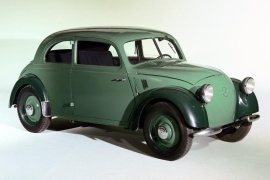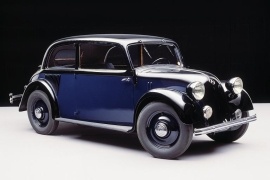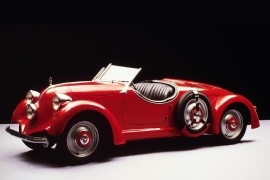MERCEDES BENZ Typ 130, 150 and 170 H Models/Series Timeline, Specifications & Photos
First production year: 1934
Engines: Gasoline
In 1936, Mercedes-Benz showed a compact car designed for the masses: the 170 H. It was part of the new trend among the ambitious automotive designers to move away from the rigid rear axle toward an independent suspension, rear- or mid-engine and a streamlined body.
The new trend was set by pioneers such as Edmund Rumpler, Hans Ledwink, Gustav Rohr and Joseph Ganz, the editor in chief of the “Motor Kritik” magazine. The latter was a strong advocate for streamlined cars. These engineers played a major role in the development of the 130H, a car that featured full carpeting inside, instead of the regular rubber mats and other amenities inspired by the luxury department.
The 130 H failed to convince the buyers but, in February 1936, the 170 H (W28) made its debut at the International Motor and Motorcycle Show in Berlin along with its sister model, the 170 V. The “H” letter stood for “Heck motor” meaning the car was equipped with a rear-engine, while the “V' letter was used for front-engine versions.
The 170 H and 170 V had originally been designed with a 1.6-liter engine. Based on the 1.3-liter engine, this power unit, under development since 1933, had originally been intended to power the rear-engined model from as early as 1935. The increased displacement, achieved by increasing the bore and stroke, was performed to increase the torque. The body of the 170 H, had harmonious and balanced lines than its predecessor, the 130H, and received the general approval.
Mercedes-Benz introduced the Typ 130 at the 1934 International Motor and Motorcycle Show in Berlin at the same time as the prestigious 500 K series, and it was the smallest vehicle in the carmaker's portfolio.
Before the W23, the German automaker tried the solution of rear-engined vehicles on the W17 platform, but those versions didn't reach the assembly line. But based on the results from those experiments, Mercedes-Benz created the Typ 130, which became the first production car in the world with the engine mounted in the back. At 3,200 RM (Reichmarks), the car was a bargain compared to the 22,000 RM 500 K.
With its humble design, the W23 featured rounded shapes with no radiator grille at the front. Its tall luggage compartment was there and was flanked on the sides by a pair of headlights supported by the arched wheel fenders. On its sides, the two-door vehicle featured flat panels and an air intake above the rear wheel arches. But the rear end was the most intriguing, with its sloped-down shape, extended more than most regular cars from that era due to the flat-four engine mounted behind the axle.
Inside, there was nowhere near as luxurious as any other Mercedes-Benz on the market. Still, it featured two seats at the front and a bench in the back for two passengers. Access was difficult due to the small rear-hinged doors, but acceptable.
The car's platform featured swing axles, with leaf springs up front and coils in the back. The air-cooled engine was not very powerful and was paired with a three-speed manual. But that was enough for many. Still, unfortunately, the car's sales didn't go as good as expected, and the W23 was withdrawn from the assembly lines just two years later.
In the late '20s, new ideas emerged for automotive design. Three of them were more important than the others: independent rear suspension, mid-engine cars, and streamlined bodies.
The 150 (W30) was developed as a sport-coupe for racing. But the standard names for that era was "sports saloon". Its closed body was somehow weird looking for the era, with two headlights and one, middle, projector. The sloped rear end had a special purpose: it hosted the engine. Unlike other cars from its era, the 150 used a mid-engine concept, with the engine and transmission fore and aft of the rear axle, respectively.
The engine was based on a 1.3-liter air-cooled unit, but with an increased displacement up to 1.5-liter. It delivered 55 hp, which was a lot for that era. To gain that output, a double-barrel carburetor was installed and it had overhead camshafts. All of these technological updates paid-off when the 150 sports saloon won four gold medals at the 2000-kilometer (1200 miles) endurance race across Germany in July 1934. The greatest sports saloon's triumph was achieved at the end of 1934 when it led the race between Rome and Pisa on the famous Liege-Rome-Liege Rally.
At the end of 1934, the competition vehicle served as the basis for developing the 150 sports roadster (W 130), but the atypical styling for a Mercedes-Benz vehicle did not make it into production.


